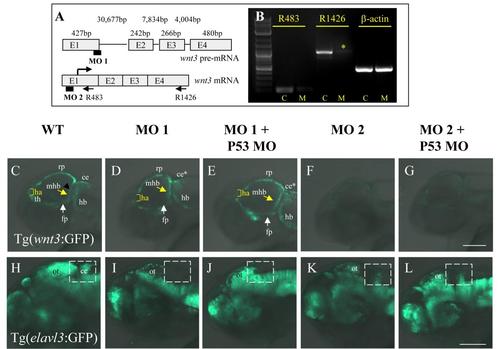Fig. S3
- ID
- ZDB-FIG-151208-10
- Publication
- Teh et al., 2015 - Modulating expression level of secreted Wnt3 influences cerebellum development in zebrafish transgenics
- Other Figures
- All Figure Page
- Back to All Figure Page
|
Interference with Wnt3 function disrupts cerebellar differentiation. (A) Organization of the wnt3 pre-mRNA and regions targeted by wnt3 MOs, MO 1 (targets wnt3 exon1-intron 1 boundary) and MO 2 (targets wnt3 5′UTR). The length of each exon and intervening intron is indicated. (B) RT-PCR analysis of wnt3 in wild type and morphants (MO1) at 30 hpf. Wnt3 knockdown upon microinjection of MO1 interfere with formation of wild type wnt3 transcripts highlighted by (*). Abbreviation: control (C); MO1 injected morphants (M). (C-G) Only microinjection of translation blocking MO (MO2) whose recognition site is present in the wnt3 regulatory element successfully interferes with GFP expression in Tg(wnt3:EGFP)F1. (H-L) Wnt3 deficiency through either microinjection of MO1 or MO2 with or without p53 MO consistently reduces GFP-positive neurons in the cerebellum (ce) of 72hpf Tg(elav:GFP) embryos. Insert scale bar is 50 µm. |

